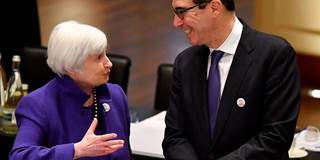The Truth Behind Today’s US Inflation Numbers
When the US Federal Reserve began to raise interest rates in December 2015, it issued a median forecast that, in retrospect, significantly overstated the strength of the US economy. This suggests that the Fed's monetary policies, in combination with fiscal policies, are not doing enough to stimulate the US economy.
BERKELEY – In December 2015, the US Federal Reserve embarked on a monetary-tightening cycle, by raising the target range for the short-term nominal federal funds rate by 25 basis points (one-quarter of a percentage point). At the time, the Federal Open Market Committee (FOMC) – the Fed body that sets monetary policy – issued a median forecast predicting three things.
First, the FOMC indicated that the December 2015 rate increase would be the first of five such increases that it would make within the subsequent year, and the first of nine that would take place by, say, September 2017. Second, the federal funds rate would reach 2.25-2.5% within three months of the December 2015 increase. And, third, the Fed’s preferred measure of inflationary pressure – the core personal consumption expenditures (PCE) price index – would be at 1.9% per year by now.
All told, the FOMC’s forecast has not been borne out. If the Fed actually does increase interest rates this month, it will have undertaken only four of the nine anticipated rate hikes. Moreover, it believed that nine rate hikes before the end of this summer would be necessary to keep inflation below its target of 2% per year. But inflation is expected to rise at an annual rate of just 1.5% for the rest of this year, and next year.



BERKELEY – In December 2015, the US Federal Reserve embarked on a monetary-tightening cycle, by raising the target range for the short-term nominal federal funds rate by 25 basis points (one-quarter of a percentage point). At the time, the Federal Open Market Committee (FOMC) – the Fed body that sets monetary policy – issued a median forecast predicting three things.
First, the FOMC indicated that the December 2015 rate increase would be the first of five such increases that it would make within the subsequent year, and the first of nine that would take place by, say, September 2017. Second, the federal funds rate would reach 2.25-2.5% within three months of the December 2015 increase. And, third, the Fed’s preferred measure of inflationary pressure – the core personal consumption expenditures (PCE) price index – would be at 1.9% per year by now.
All told, the FOMC’s forecast has not been borne out. If the Fed actually does increase interest rates this month, it will have undertaken only four of the nine anticipated rate hikes. Moreover, it believed that nine rate hikes before the end of this summer would be necessary to keep inflation below its target of 2% per year. But inflation is expected to rise at an annual rate of just 1.5% for the rest of this year, and next year.